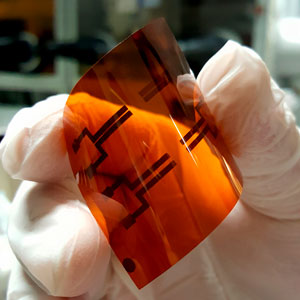Less is more to produce top-notch 2D materials

Transparent flexible electronics based on 2D materials. © 2017 A*STAR Institute of Materials Research and Engineering
Molybdenum trioxide (MoO3) has potential as an important two-dimensional (2D) material, but its bulk manufacture has lagged behind that of others in its class. Now, researchers at A*STAR have developed a simple method for mass producing ultrathin, high-quality MoO3 nanosheets. [1]
Following the discovery of graphene, other 2D materials such as transition metal di-chalcogenides, began to attract considerable attention. In particular, MoO3 emerged as an important 2D semiconducting material because of its remarkable electronic and optical properties that hold promise for a range of new applications in electronics, optoelectronics and electrochromics.
Liu Hongfei and colleagues from the A*STAR Institute of Materials Research and Engineering and Institute of High Performance Computing have sought to develop a simple technique for mass producing large, high-quality nanosheets of MoO3 that are flexible and transparent.
“Atomically thin nanosheets of molybdenum trioxide have novel properties that can be utilized in a range of electronic applications,” says Liu. “But to produce good quality nanosheets, the parent crystal must be of very high purity.”
By first using a technique called thermal vapor transport, the researchers evaporated MoO3 powder in a tube-furnace at 1,000 degrees Celsius. Then, by reducing the number of nucleation sites, they could better match the thermodynamic crystallization of MoO3 to produce high-quality crystals at 600 degrees Celsius without the need for a specific substrate.
“In general, crystal growth at elevated temperatures is affected by the substrate,” explains Liu. “However, in the absence of an intentional substrate we could better control the crystal growth, allowing us to grow molybdenum trioxide crystals of high purity and quality.”
After cooling the crystals to room temperature, the researchers used mechanical and aqueous exfoliation to produce submicron-thick belts of MoO3 crystals. Once they subjected the belts to sonication and centrifugation, they were able to produce large, high-quality MoO3 nanosheets.
The work has provided new insights into the interlayer electronic interactions of 2D MoO3 nanosheets. The crystal growth and exfoliation techniques developed by the team could also be helpful in manipulating the band gap — and therefore the optoelectronic properties — of 2D materials by forming 2D heterojunctions.
“We are now attempting to fabricate 2D MoO3 nanosheets with larger areas, as well as exploring their potential use in other devices, such as gas sensors,” says Liu.
The A*STAR-affiliated researchers contributing to this research are from the Institute of Materials Research and Engineering and Institute of High Performance Computing. For more information about the team’s research, please visit the Electronic Materials (ELE) webpage.
Journal information
[1] Liu, H., Cai, Y., Han, M., Guo, S., Lin, M., Zhao, M., Zhang, Y. & Chi, D. Aqueous and mechanical exfoliation, unique properties and theoretical understanding of MoO3 nanosheets from free standing a-MoO3 crystals: Raman mode softening and absorption edge blue shift. Nano Research advance online publication, 10 August 2017.
Media Contact
All latest news from the category: Materials Sciences
Materials management deals with the research, development, manufacturing and processing of raw and industrial materials. Key aspects here are biological and medical issues, which play an increasingly important role in this field.
innovations-report offers in-depth articles related to the development and application of materials and the structure and properties of new materials.
Newest articles

“Nanostitches” enable lighter and tougher composite materials
In research that may lead to next-generation airplanes and spacecraft, MIT engineers used carbon nanotubes to prevent cracking in multilayered composites. To save on fuel and reduce aircraft emissions, engineers…

Trash to treasure
Researchers turn metal waste into catalyst for hydrogen. Scientists have found a way to transform metal waste into a highly efficient catalyst to make hydrogen from water, a discovery that…

Real-time detection of infectious disease viruses
… by searching for molecular fingerprinting. A research team consisting of Professor Kyoung-Duck Park and Taeyoung Moon and Huitae Joo, PhD candidates, from the Department of Physics at Pohang University…





















